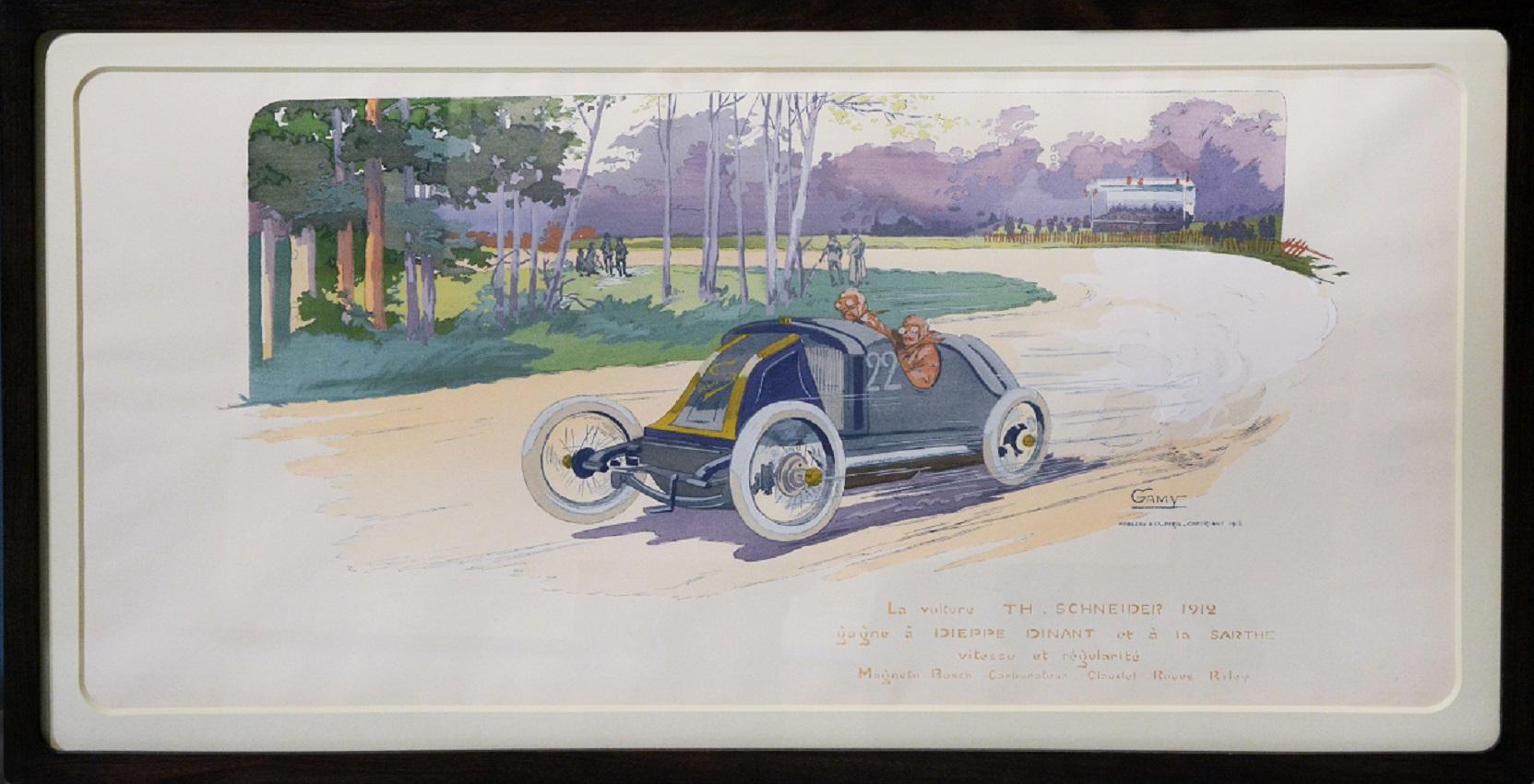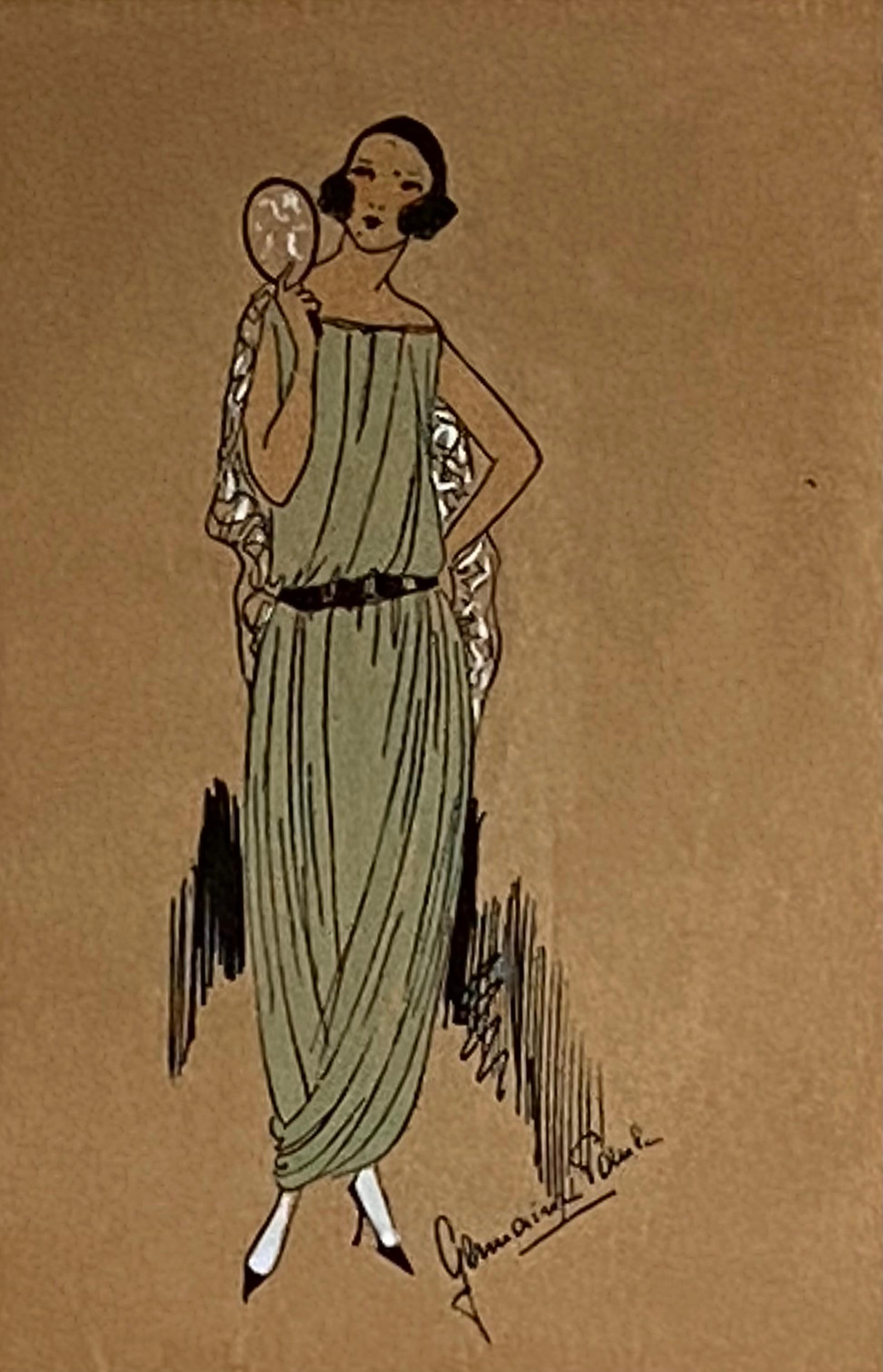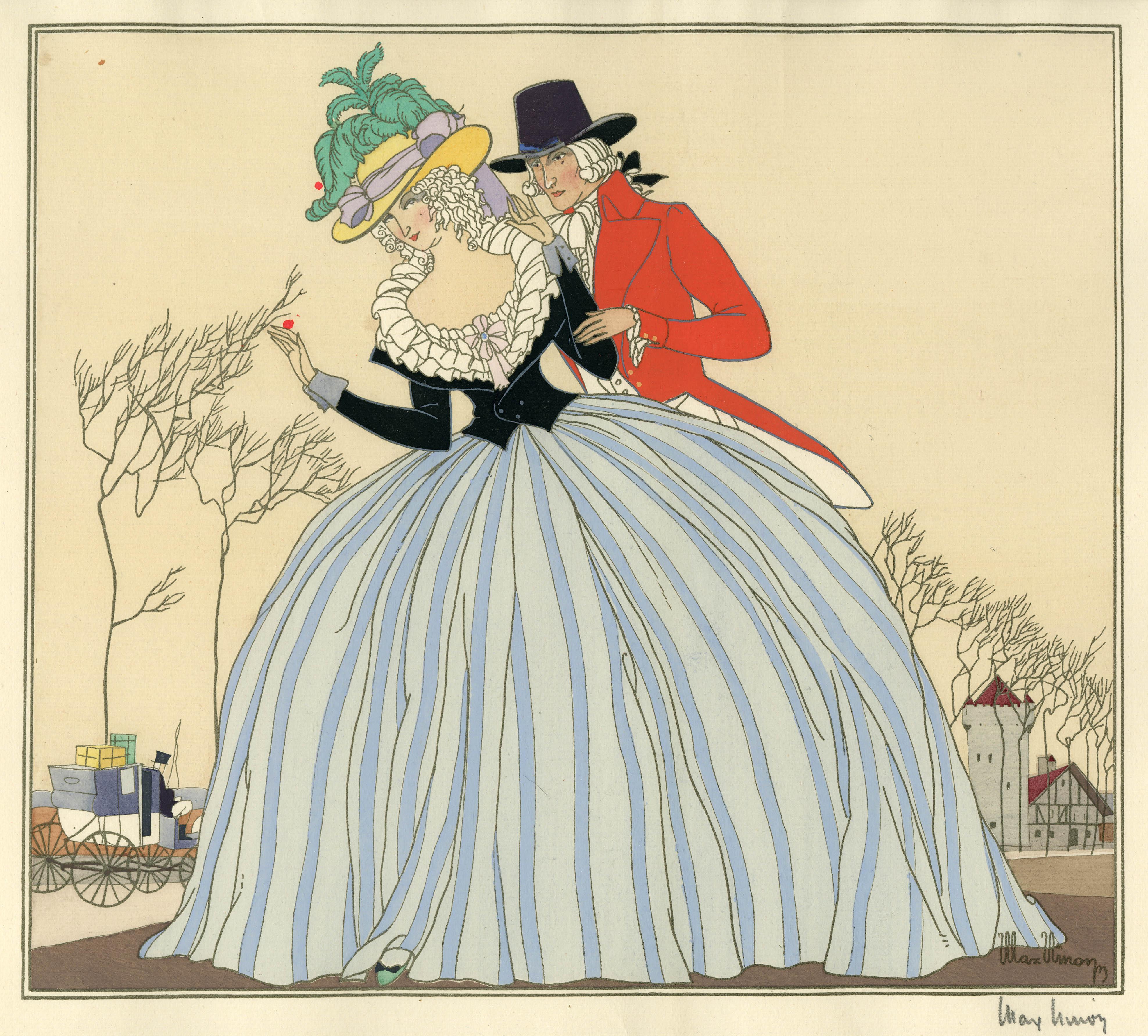Items Similar to 'Variations, 10' — 1920s French Art Deco Pochoir
Want more images or videos?
Request additional images or videos from the seller
1 of 6
Edouard Benedictus'Variations, 10' — 1920s French Art Deco Pochoir1923
1923
About the Item
Edouard Benedictus, 'Variations, plate 10' from the portfolio 'Variations Quatre-Vingt-Six Motifs Décoratifs en Vingt Planches', color pochoir, edition not stated, 1923. Signed in the matrix, in the left bottom margin. A superb, painterly impression, with fresh, vivid colors and metallic silver, on heavy, cream wove paper with margins (1 to 1 3/4 inches). A repaired tear in the center left margin, not affecting the image, in good condition. Archivally sleeved, unmatted.
Image size 14 3/8 x 11 9/16 inches; sheet size 17 3/8 x 13 7/8 inches.
The pochoir production is by Jean Saudé, the French printmaker known for his mastery of the technique and the author of the first how-to book on the pochoir process. Published by Éditions Albert Levy, Librairie Centrale des Beaux-Arts, Paris.
Collections: Metropolitan Museum of Art, Minneapolis Institute of Art, New York Public Library, Victoria and Albert Museum.
Additional works from this suite of vibrant Art Deco floral designs are available from Keith Sheridan LLC; please inquire.
ABOUT THIS WORK
Pochoir is a refined stencil-based technique employed to create multiples or to add color to prints produced in other mediums. Characterized by its crisp lines and rich color, the print-making process was most popular from the late 19th century through the 1930s, with its center of activity in Paris. The pochoir process began with the analysis of an image’s composition, including color tones and densities. The numerous stencils (made of aluminum, copper, or zinc) necessary to create a complete image were then designed and hand-cut by the 'découpeur.' The 'coloristes' applied watercolor or gouache pigments through the stencils, skillfully employing a variety of different brushes and methods of paint application to achieve the desired depth of color and textural and tonal nuance. The pochoir process, by virtue of its handcrafted methodology, resulted in the finished work producing the effect of an original painting, and in fact, each print was unique.
ABOUT THE ARTIST
Edouard Benedictus (1878 -1930), artist, designer, composer, and chemist, was born and died in Paris. A highly-regarded designer and art critic of the Art Nouveau era, Benedictus gained renown as a colorist and creator of Art Deco-inspired geometric and floral motifs. His work had a significant influence on international fashions in clothing, home furnishings, graphic design, and decorative objects of the period, earning him commissions from leading European design firms. In 1925 he was invited to represent Art Deco textile design in the Pavillion de l'Ambassade Francaise at the important Exposition des Arts Decoratifs in Paris. Benedictus’ work is held in the collections of the Musee d'Orsay (Paris), Musee National des Beaux-Arts du Quebec, the U. S. Library of Congress, the Art Institute of Chicago, the Minneapolis Museum of Art, and the Victoria and Albert Museum (London).
Benedictus is also credited with the invention of shatter-proof glass in 1903. Having accidentally knocked a beaker off of a shelf in his studio and seeing that the pieces were surprisingly still connected, he surmised that it had to do with the liquid nitrocellulose that the beaker contained. Some experimenting finally produced what he called "laminated glass," in which a layer of celluloid was bonded between two sheets of glass. He patented his invention in 1909, and it became widely used during World War I; by 1919, Henry Ford was installing the glass in all of his automobiles. Refinements of the process lead to the 1936 invention of polyvinyl butyral, today's basis for bulletproof glass.
For his achievements in art and science, Benedictus was awarded a ‘Knight of the Legion of Honor’ and an ‘Officer of the Legion of Honor’ by the French Government.
- Creator:Edouard Benedictus (1879 - 1930, French)
- Creation Year:1923
- Dimensions:Height: 14.44 in (36.68 cm)Width: 11.57 in (29.39 cm)
- Medium:
- Movement & Style:
- Period:
- Condition:
- Gallery Location:Myrtle Beach, SC
- Reference Number:
About the Seller
5.0
Recognized Seller
These prestigious sellers are industry leaders and represent the highest echelon for item quality and design.
Platinum Seller
These expertly vetted sellers are 1stDibs' most experienced sellers and are rated highest by our customers.
Established in 1995
1stDibs seller since 2016
254 sales on 1stDibs
Typical response time: 1 hour
Associations
International Fine Print Dealers Association
- ShippingRetrieving quote...Ships From: Myrtle Beach, SC
- Return PolicyA return for this item may be initiated within 7 days of delivery.
More From This SellerView All
- Naked Young Man Sitting On Lopped Branch; Naked Young Woman Sitting on a Branch.By Eric GillLocated in Myrtle Beach, SCWood engraving, 1930, edition small, Physick 642 / 643. Initialed in pencil. Two blocks printed on a single sheet: fine impressions on cream laid Japan with full margins (1 1/2 to 2...Category
1930s Art Deco Figurative Prints
MaterialsWoodcut
- DancersBy Charles TurzakLocated in Myrtle Beach, SCCharles Turzak, 'Dancers', 1939, wood engraving, edition 100. Signed, titled, and numbered 72/100 in pencil. A fine, richly-inked impression, on off-white Japan paper, with full marg...Category
Mid-20th Century Art Deco Figurative Prints
MaterialsWoodcut
- Untitled (Profile of an African Woman)By Boris Lovet-LorskiLocated in Myrtle Beach, SCBoris Lovet-Lorski, 'Untitled (Profile of a Black Woman)', lithograph, edition 250, 1929. Signed and numbered 14 in pencil. Number 14 of Volume 2, a series of 10 lithographs publishe...Category
1920s Art Deco Figurative Prints
MaterialsLithograph
- Untitled (Nike)By Boris Lovet-LorskiLocated in Myrtle Beach, SCBoris Lovet-Lorski, Untitled (Nike), lithograph, edition 250, 1929. Signed and numbered 1 in pencil. Number 1 of Volume 1, a series of 10 lithographs in each of 2 portfolios, publish...Category
1920s Art Deco Figurative Prints
MaterialsLithograph
- Portrait of an African Woman — 1920s ModernismBy Boris Lovet-LorskiLocated in Myrtle Beach, SCBoris Lovet-Lorski, Untitled (Portrait of an African Woman), lithograph, edition 250, 1929. Signed and numbered 13 in pencil. Number 13 of Volume 2, a series of 10 lithographs publis...Category
1920s Art Deco Figurative Prints
MaterialsLithograph
- 'Abstract Boats' — 1930s American Modernism, WPABy Leon BibelLocated in Myrtle Beach, SCLeon Bibel, 'Abstract Boats', color serigraph, 1938, edition 12. Signed, dated, and numbered ' /12' in pencil. A fine, painterly impression, with fresh colors, on buff wove paper; t...Category
1930s American Modern Figurative Prints
MaterialsScreen
You May Also Like
- Cycles Motos Alcyon.Located in London, GBGAMY and MONTAUT, Ernest. Cycles Motos Alcyon. [Paris: Mabileau & Co., c. 1914]. Hand-coloured pochoir print. Framed and glazed, overall size: 93.6cm x 49.2cm. The Gamy-Montaut ...Category
1910s Art Deco Figurative Prints
MaterialsScreen, Stencil
- L’Allumage Moderne.Located in London, GBGAMY and MONTAUT, Ernest. L’Allumage Moderne. Magneto Lavalette Eisemann. [Paris: Mabileau & Co., c. 1910]. Hand-coloured pochoir print. Framed and glazed, overall size: 93.6cm x ...Category
1910s Art Deco Figurative Prints
MaterialsScreen, Stencil
- Grand Prix de l’A.C.F. 1913 (Motocyclettes).Located in London, GBGAMY and MONTAUT, Ernest. Grand Prix de l’A.C.F. 1913 (Motocyclettes), 1er. Greame Fenton sur autocyclette CLEMENT - PNEU DUNLOP - Carburateur Longuemare bougie Eyquem. Mabileau & ...Category
1910s Art Deco Figurative Prints
MaterialsScreen, Stencil
- La Voiture Th. Schneider, Car - 1912Located in London, GBGAMY and MONTAUT, Ernest. La Voiture Th. Schneider, 1912 gagne à Dieppe Dinant et à la Sarthe vitesse et régularité / Magneto Bosch Corburateur Claudel Roues Riley. Mabileau & Co., ...Category
1910s Art Deco Figurative Prints
MaterialsScreen, Stencil
- “Sylvia”Located in Southampton, NYOriginal fashion illustration for Tres Parisien, December, 1921 Moroccan Crepe Dress by Germaine-Paule Joumard, Fashion Art Deco Pochoir on Chinese Paper. Artwork size is 7.5 by 5 i...Category
1920s Art Deco Figurative Prints
MaterialsArchival Paper, Stencil
- CoquetteBy Victor Max NinonLocated in Fairlawn, OHCoquette Pochoir (silk screen) printed in colors, c. 1923-1925 Signed by the artist in pencil lower right; numbered in ink on the image, (see photo) Edition: 250 (100/250) in pencil in image (see photo) Image size: 10-1/2 x 12-3/4" The artist won a gold medal in Paris in 1925 for his porchoirs Victor Max Ninon (Vittorio Accornero de Testa, Italian, 1896-1982) Biography Vittorio Accornero de Testa was born in Casale Monferrato in 1896. He completed his first studies at the "Leardi" institute, but was forced to interrupt them due to the war events of the First World War . At 19 he was second lieutenant of the Alpine troops and in 1916 he took one of the first pilot's licenses. During the war he knows the bitterness of shooting down in air combat (for which he is decorated), but also the good fortune to stay alive, albeit with a disability. His art blossomed in the postwar period, first signing his works simply Ninon and then, probably at the suggestion of a French publisher, under the pseudonym of "Victor Max Ninon" (Victor and Max indicate strength and masculinity, Ninon boyhood) .In 1919 and 1924 he made illustrations for theGiornalino della Domenica , also together with his first wife Edina Altara , for Ardita and La Lettura . In 1923 he won the cover competition organized by the magazine El Hogar of Buenos Aires and in 1925 with his pochoirs he imposed himself in Paris at the international exhibition of modern decorative and industrial arts , obtaining a gold medal. In the same year he made two covers for the US magazine The Smart Set . In the 1920s he made numerous series of art deco style postcards for the Milanese publishing house Degami . On June 4, 1929, aGenoa embarks on the Conte Grande together with his wife Edina Altara , for New York . The two stayed in the American metropolis for a few months: in this period Accornero worked on the creation of theatrical sets and created some covers for Country Life magazine . Accornero gets awards and prizes, but the great economic crisis of the time and the nostalgia for Italy convince the two to return to their homeland, where they resume their activity as illustrators. In 1934 Accornero moved to Milan, separated amicably from his wife and continued to dedicate himself to the illustration of children's books, abandoning the pseudonym Victor Max Ninon. It illustrates about 60 books, from the fables of Andersen , Perrault and Grimm , to the tales of Poe , as well as the famous Pinocchio and Cuore published by Mondadori, Mursia, Hoepli, Martello. Several books illustrated by Accornero have been published in French, Spanish, German and English. In addition to the periodicals already mentioned, he collaborates on the first edition of the Encyclopedia of Boys , Mondadori, and with the Italian magazines Lidel , Il Secolo XX, The Italian Illustration , Fantasies of Italy , The Woman , Cordelia , For You Lady , Grace , Metropolis , La Domenica del Corriere , The Corriere dei Piccoli . In 1936 enters the world of cinema, creating sets and costumes for Wedding Vagabonde of Guido Brignone and The White Squadron of Augustus Genina . From 1935 to 1950 he also devoted himself to the theater, taking care of sets and costumes for numerous operettas, ballets and performances at the Scala in Milan and for the Milanese theaters Manzoni, Lirico and Olympia. Stages Marcello di Giordano, Nina pazza d'amore by Paisiello, I cantori di Nurimberga by Wagner, La Bohème by Puccini and other works. For this activity he is also cited in the Theater encyclopedia. In the 1940s and 1950s he wrote and illustrated six books for children for Mondadori: Tomaso (1944), Giacomino (1949), Tomaso Cacciatore (1950), Zio Stefano (1950), In Campagna che delizia! (1953), Tomaso, dear Tomaso (1955). His illustrations of Perrault's Tales published in those years by Hoepli are famous. His art in the fifties evolves towards hyperrealism . There are many personal exhibitions in Italy and abroad, including those at the Gallerie Gussoni (1959) and Bolzani (1963 and 1966) in Milan and Walcheturm (1962) in Zurich. Eminent critics praise his work, from Orio Vergani to Enrico Piceni, from Reto Roedel to De Chirico himself. On the Domenica del Corriere , the journalist, writer and painter Dino Buzzati...Category
1920s Art Deco Figurative Prints
MaterialsStencil





